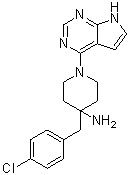CCT128930
This product is for research use only, not for human use. We do not sell to patients.

For small sizes, please check our retail website as below: www.invivochem.com
| Size | Price | Stock |
|---|---|---|
| 250mg | $950 | Check With Us |
| 500mg | $1550 | Check With Us |
| 1g | $2325 | Check With Us |
Cat #: V0163 CAS #: 885499-61-6 Purity ≥ 98%
Description: CCT128930 is a novel, potent, ATP-competitive and selective pyrrolopyrimidine-based inhibitor of Akt2 (IC50 = 6 nM in a cell-free assay) with potential anticancer activity.
Top Publications Citing Invivochem Products
Publications Citing InvivoChem Products
Product Promise

- Physicochemical and Storage Information
- Protocol
- Related Biological Data
- Stock Solution Preparation
- Quality Control Documentation
| Molecular Weight (MW) | 341.84 |
|---|---|
| Molecular Formula | C18H20ClN5 |
| CAS No. | 885499-61-6 |
| Storage | -20℃ for 3 years in powder formr |
| -80℃ for 2 years in solvent | |
| Solubility In Vitro | DMSO:68 mg/mL (198.9 mM)r |
| Water: <1 mg/mLr | |
| Ethanol: 6 mg/mL (17.55 mM) | |
| Solubility In Vivo | 1% DMSO+30% polyethylene glycol+1% Tween 80: 11mg/mL |
| SMILES Code | NC1(CC2=CC=C(Cl)C=C2)CCN(C3=C4C(NC=C4)=NC=N3)CC1 |
| Synonyms | CCT128930; CCT-128930; CCT 128930 |
| Protocol | In Vitro | The GI50 values of CCT128930 for growth inhibition are 6.3 μM for U87MG human glioblastoma cells, 0.35 μM for LNCaP human prostate cancer cells, and 1.9 μM for PC3 human prostate cancer cells, all of which are PTEN-deficient human tumor cell lines.CCT128930 inhibits direct substrates of AKT (Ser9 GSK3β, pThr246 PRAS40 and pT24 FOXO1/p32 FOXO3a) at ≥5 μM, and the downstream target, pSer235/236 S6RP at ≥ 10 μM, with generally constant levels of the respective total proteins and GAPDH. CCT128930 (0.1-60 μM; 1 hour; U87MG human glioblastoma cells) shows an initial induction of AKT phosphorylation at serine 473 up to 20 μM, followed by a decreased in phosphorylation at higher concentrations. CCT128930 (PTEN-null U87MG human glioblastoma cells; over a 24-hour time period) results in an increase in G0/G1 phase cells from 43.6% to 64.8% after 24 hours of treatment. CCT128930 (18.9 μM; U87MG human glioblastoma cells) causes an increase in phosphorylation of pSer473 AKT after 30 minutes, which is sustained for 48 hours. Total AKT protein signal decreases gradually from 8 hours to 48 hours of treatment. |
|---|---|---|
| In Vivo | Summary of the pharmacokinetic parameters of CCT128930 (25 mg/kg) in CrTacNCr-Fox1nu mice. CCT128930 (25 or 40 mg/kg; i.p. daily or twice daily for 5 days) shows antitumor activities in U87MG and BT474 human breast cancer xenografts. |
These protocols are for reference only. InvivoChem does not
independently validate these methods.
| Solvent volume to be added | Mass (the weight of a compound) | |||
|---|---|---|---|---|
| Mother liquor concentration | 1mg | 5mg | 10mg | 20mg |
| 1mM | 2.9253 mL | 14.6267 mL | 29.2535 mL | 58.5069 mL |
| 5mM | 0.5851 mL | 2.9253 mL | 5.8507 mL | 11.7014 mL |
| 10mM | 0.2925 mL | 1.4627 mL | 2.9253 mL | 5.8507 mL |
| 20mM | 0.1463 mL | 0.7313 mL | 1.4627 mL | 2.9253 mL |
The molarity calculator equation
Mass(g) = Concentration(mol/L) × Volume(L) × Molecular Weight(g/mol)
Mass
=
Concentration
×
Volume
×
Molecular Weight*
The dilution calculator equation
Concentration(start)
×
Volume(start)
=
Concentration(final)
×
Volume(final)
This equation is commonly abbreviated as: C1 V1 = C2 V2
Concentration(start)
C1
×
Volume(start)
V1
=
Concentration(final)
C2
×
Volume(final)
V2
Step One: Enter information below
Dosage mg/kg
Average weight of animals g
Dosing volume per animal µL
Number of animals
Step Two: Enter the in vivo formulation
%DMSO
+
%
+
%Tween 80
+
%ddH2O
Calculation Results:
Working concentration:
mg/ml;
Method for preparing DMSO master liquid:
mg
drug pre-dissolved in
µL
DMSO(Master liquid concentration
mg/mL)
,Please contact us first if the concentration exceeds the DMSO solubility of the batch of drug.
Method for preparing in vivo formulation:
Take
µL
DMSO master liquid, next add
µL
PEG300, mix and clarify, next add
µL
Tween 80,mix and clarify, next add
µL
ddH2O,mix and clarify.
Note:
- (1) Please be sure that the solution is clear before the addition of next solvent. Dissolution methods like vortex, ultrasound or warming and heat may be used to aid dissolving.
- (2) Be sure to add the solvent(s) in order.




































